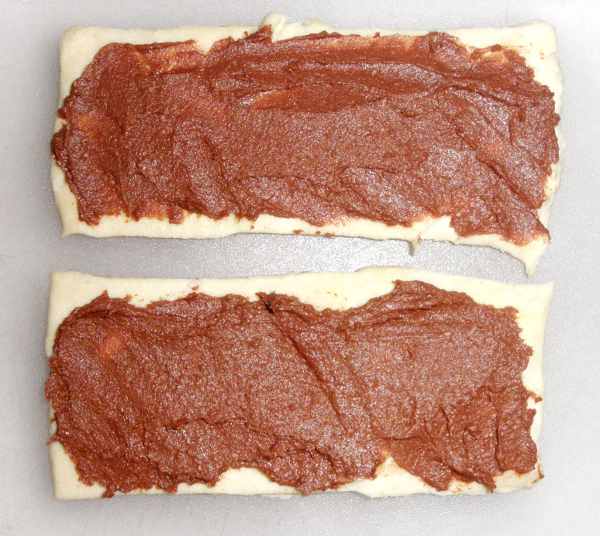[Equipment: convection oven with water tray for steam baking, baking tray with silicone mat. For more information about the terminology in this recipe, see Low Temperature Baking: A Journey of 3 Paths.]
Steam baking and mochi flour keep these low-fat brioche buns moist without lots of oil or butter. Because there is so little butter, it is rubbed into the flour for even distribution. For a chewy texture, I use pizza crust yeast, which contains dough relaxing enzymes. Regular rapid-rise yeast should substitute nicely, with a higher rise and lower density texture. The filling is low-fat too, a mixture of mashed potato flakes and brown sugar. To form the flower shape, I divide the dough into 6 portions, shape each one into a rectangular strip, fill and fold and then roll up and bake.
Makes 6 buns
– 200 calories per bun
– Oven Temperature: effective 250°F/121°C (steam baking)
Cherry Cinnamon Filling:
- 12 cherries, halved and pitted
- 1/2 cup mashed potato flakes
- 1/4 cup brown sugar
- 1 tablespoon cinnamon
- 3/8 cup milk
- 1/4 teaspoon allspice
- 2 teaspoons butter, softened
Mochi Brioche Dough:
- 3/4 cup whole wheat flour
- 1/2 cup mochi flour or glutinous rice flour
- 1-1/2 teaspoons pizza crust yeast or rapid rise yeast
- pinch of salt
- 1/8 cup sugar
- 1 egg yolk
- 2 teaspoons butter
- 1/4 to 1/2 cup warm milk (130°F/54.4°C)
Dried Cherries Method:
1. Slice cherries in half and discard pits. Place cherries on baking mat, juicy side up.
2. Dehydrate cherries at 150F/C until the top surface is dry but the cherries are still pliable. Set aside.
Cinnamon Filling Method:
1. In a medium bowl, whisk the mashed potato flakes, brown sugar and spices until combined.
2. In a small bowl, mix the milk and egg yolk. With a fork, stir in the liquid until all ingredients are moistened. Continue stirring to break up mixture into a sandy, granular texture
3. Mix in softened butter, keeping mixture light and granular. Cover and set aside.
Buns Method:
1. In a large bowl, mix all the dry ingredients except the yeast.
2. Dice butter and add to flour. Rub butter with hands or cut butter with a pastry cutter until the mixture has a lightly sandy consistency.
3. In a small bowl, whisk together the milk and egg yolk.
4. Drizzle the milk over the flour. With a fork, stir the liquid into the flour until it forms a dough that holds its shape when squeezed.
5. Knead the dough for about 4 minutes until the surface is smooth.
6. Allow to rise in a proofing box or other warm place until double in bulk.
7. Gently deflate the dough and divide into 6 portions.
8. Roll each portion into a rectangle about 7-1/2 x 2 inches.
9. Fill only the top half of the rectangle. Place 4 dried cherry halves at one end. Spread about 2 tablespoons of the cinnamon filling along the remainder. Sprinkle 1 teaspoon of chopped nuts over the filling.
10. Beginning at the end with the cherries, fold the dough up to cover the filling. Then roll it into a standing spiral with the open end facing up. Pinch the end into the bun to seal.
11. Place each bun in a greased muffin cup. Cover and let rise in a proofing box or other warm place for about 30 to 40 minutes or until rolls have blossomed over the cups.
12. Prepare the convection oven for steam baking with an open water tray. Preheat the oven to an effective temperature of 250°F/121°C (my oven dial was set to 300°F/150°C and the effective temperature checked with a thermometer). Place a trivet in the tray to hold the muffin tin above the water line. Steam bake for about 30 minutes or the rolls are lightly golden.
13. Serve hot or warm.



























































































































































You must be logged in to post a comment.